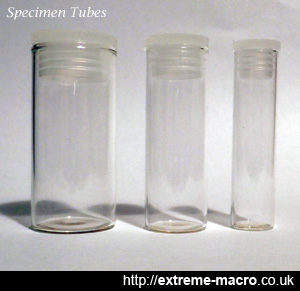Freezing Insects
by Johan J Ingles-Le Nobel
Last updated August 31, 2017
Freezing insects is one of several options available to entomologists seeking to preserve them for detailed specimen preservation.
Freezing is probably the most common method to get freshly killed specimens in good condition to photographFreezing insects has the added benefit that you don't need to use chemicals, although it's not a suitable killing method for every type of insect. It doesn't work well for soft-bodies insects and larvae. Freezing is probably the most common method to get freshly killed specimens in good enough condition to document photographically for museum or voucher specimen purposes.
Method
With freezing, specimens are placed in small airtight containers and put into a freezer. The temperature usually inhibits movement within minutes hence also preventing excessive damage to the specimen.
Care should be taken to make sure that the container gives the specimen maximum opportunity to move into a position that ensures the extremily brittle parts don't snap when the container is thawed. Frozen specimens are exceptionally brittle and I personally prefer to lay specimen containers on their side giving maximum legroom for a sturdy position.

Glass specimen tubes with airtight push-on lids used to freeze specimens. Make sure the containers are meticulously clean (I use an ultrasonic cleaner) and only use one specimen per tube. It seems to be the case that the larger the tube relative to the specimen, the dirtier they get whilst moving in the tube - one inch pots make for dirty specimens. I find it easier to use push on lids rather than screw on lids.
Most specimens will die overnight in a freezer but some cold resistant insects may require a week or more. Kept frozen, specimens do not dry out as quickly and can later be processed by pinning and mounting them, eliminating the need for relaxing. Once the specimen is thawed, legs and wings can be moved to position them before letting them dry for display. They will also usually retain some colour patterns such as eye colors in horse and deer flies, but colours do quickly fade as the specimen dries and dessicates.
Soft Bodied Specimens
thaw out with the lid kept on the tubeSoft bodied insects and larvae are a particular problem as chemicals may distort the body and freezing doesn't work. Boiling them is the solution. Boiling insects in water also fixes their proteins in their digestive systems preventing them from turning black. Specimens should be left in hot water for 1-5 minutes, depending on the size of the specimens, and then transferred to the preservation liquid immediately afterwards.
Recolouring
Research has shown that suspending your insect in warm soapy water can bring the colour back to dried out fly eyes. Although this restoration technique definitely works for flies, the friends of mine who have tried it with beetles tell me that this didn't work for them with beetles. However, there are other rehydration agents that look promising such as using Decon 90.
Thawing
A special note is required about thawing frozen specimens. Specimens thaw quickly (5-15 minutes depending on size) and in terms of thawing specimens for photography purposes though, specimens should be allowed to thaw out with the lid kept on the tube to prevent condensation droplets. Otherwise there will be condensation on them and they may still be subject to rigor mortis. The flipside is the longer you wait before starting the shot, the more the eyes will deteriorate - after about 2 or so hours deterioration starts to be visible in the eyes. That said, Decon90 has proven to be an effective means to restore insect eyes back to their original condition.
Related Articles



